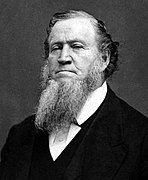
Trail of Hope: The Story of the Mormon Trail by William W. Slaughter and Michael Landon covers the founding of the Church of Christ, renamed The Church of the Latter Day Saints, and the Mormon's migration to Salt Lake City, Utah to escape persecution and to secure religious freedom. This book is the companion to the PBS documentary.
During the 1820 religious revivals in western New York, fourteen-year old Joseph Smith could not decide which religion to join. One day he walked out to a grove near his father's Palmyra farm and knelt down to pray. The boy had a vision with two "personages" appear before him. One told him that he was not to join any sect, "for they were all wrong". On the night of September 21, 1823, Smith was once again commanded and advised "that God had a work for me to do". He was told that there was a book deposited on a hill, written on gold plates, telling the history of the former inhabitants of this continent. He was also told that "the fulness (sp) of the everlasting Gospel was contained in it".
Smith visited the hill where the plates were buried once a year from 1823 to 1827. On September 22, 1827, he received them and began to translate the ancient scriptures. It took Smith three years to translate them. Finally, with financial help from a prosperous farmer, Smith published the Book of Mormon in March of 1830. A month later, thirty people met to organize the Church of Christ. Smith (above) was chosen as the leader, seer, translator and prophet of the new Church.Those of us in the area know that the first church, The Kirtland Temple, was built in Kirtland, Ohio. The Mormons were not welcome in Kirtland; and soon the "gentiles", (non-Mormons), became hostile. Finally, in 1838, the Mormons moved from Kirtland to Missouri, following another command that Smith had received during a "revelation" he had received several years prior.
In the same year there were rumors that Mormons planned on stealing the residents' land; and an "Extermination Order" was issued by Governor Boggs. In the fracas 17 Mormons were killed; and 13 were wounded. On October 31, 1838, Joseph Smith and four others were arrested and jailed. They were sentenced to death by firing squad; but everyone refused to carry out the order.
Brigham Young (1801-1877) (Pictured above)
During the winter of '38-'39, apostle Brigham Young helped guide 10,000 Mormons from Missouri to Illinois. In April of 1839, Smith and the others were "allowed to escape" and joined the group in Illinois. They settled in Commerce and renamed it Nauvoo. Nauvoo served as their headquarters from 1839-1846 and was the site of the Nauvoo Temple. Once again, in June of 1844, Smith was arrested. This time he was shot and killed. Hostility escalated; and Brigham Young announced that they would leave in the Spring of 1846 and head for the "valley of the Great Basin". On February 4, 1846 they could wait no longer and fled Illinois for Utah.
The book contains a fold-out map showing the route from Nauvoo to the Great Salt Lake.
The winters were harsh; and with only a covered wagon for shelter, it was extremely difficult for the travelers. At times they walked the same trail that the ill-fated Donner Party walked the year before. Some became ill. Historians believe it may have been Rocky Mountain Spotted Fever which was spread by the bite of a tick. The wagons only averaged about 9 miles per day; and Brigham Young and his group did not enter the valley until July 24. That date is still celebrated by the Latter-Day Saints as "Pioneer Day".
The Great Salt Lake also became a stopping point for those on their way to California; and soon there was no foraging material left for the animals, they scared away the game; and things became extremely hard for the Mormons and Native Americans in the area.
Converts were also coming from England, Germany and the Scandanavian areas. Loans were made from the Perpetual Emigrating Fund. Unfortunately some emigrants were using these funds just to come to America and not necessarily to join the Church.By 1856 funds were running low, so a handcart company was formed. Without the cost of a large wagon, animals, etc., it was a much less expensive mode of travel. As if it weren't hard enough to travel by wagon, emigrants were now making their way across the plains with everything they owned on a small handcart. They had no shelter; and they had to pull the carts over ruts and up inclines.Two of the handcart groups left too late in the season. Some became stuck in the snow; and many suffered severe frostbite. Finally a rescue party had to be launched from Utah. The travelers were starving and freezing to death. It took them 6 months and 1 week to get to their "promised land". There are two pages of an actual diary penned by a Mr. Bleak which relates the hardships and suffering that were experienced by those in the handcart groups.
To avoid another tragedy in which the groups ran out of food, the Mormons established a "down and back" wagon train to facilitate the influx of converts and provide them with much-needed food. The experienced drivers could travel as many as 20 miles per day.
The Fall of 1868 was the end of the Mormons travelling by wagon train. On May 10, 1869, the last rail was laid for the Great Iron Way from the Atlantic to the Pacific.
Reading this book is yet another result of my reading about the Donner Party several years ago. I wanted to learn more about the period in our history that was so important in the settling of the west. The harsh conditions and great sacrifices that were made to settle our country are humbling. The Mormons weren't even looking for "a better life"...They were just looking for religious freedom.
This book is 8-1/2" x 10-3/4" and is filled with pictures and drawings. It would make a good coffee table book and is sure to begin some interesting conversations. Both the book and the DVD, which is narrated by Hal Holbrook, are available at amazon.com. You can also get a good bargain from one of their many third-party sellers.
Thank you for stopping by. I hope that you will take an interest in this period of our history and expand your knowledge about how this great country of ours was settled.
The photo is from Wikimedia Commons.



